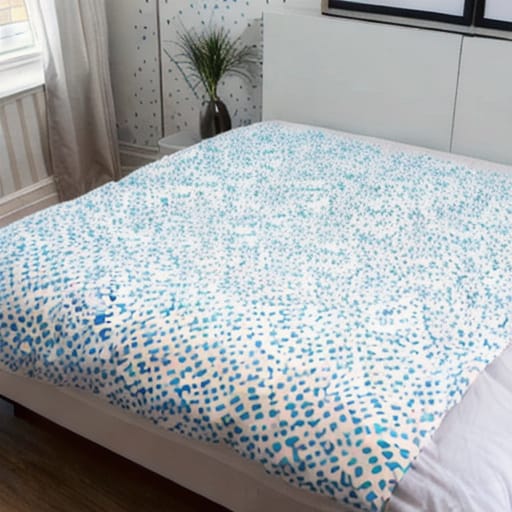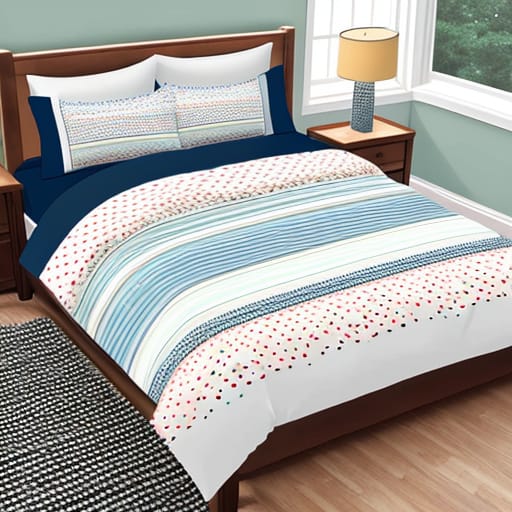When it comes to bedding essentials that make a difference in your quality of sleep, a good down comforter or duvet insert should be at the top of your list. But with so many options on the market, how do you determine which goose-down duvet is the best choice for your bedroom?
This beginner’s guide will walk you through everything you need to know when shopping for a down duvet, including key factors like fill power, construction, ethical sourcing certifications, and more. We’ll also provide tips on how to care for your down comforter properly. By the end, you’ll be able to shop with confidence and find your perfect match!
What is a Duvet Insert and How Does It Work?
A duvet insert, sometimes called a comforter, is a bedding accessory filled with insulating materials and meant to be used with a duvet cover. The duvet cover protects the insert from body oils and sweat to avoid needing to clean it frequently. Together, they create a cozy, comfortable layer for your bed.
The outer shell of the duvet insert is typically made from fabrics like cotton, cotton sateen, microfiber, wool, and silk. The inner filling tends to be down (feathers from ducks or geese that provide unmatched warmth) or down alternative materials like polyester for those with allergies.
Some key benefits of using a duvet insert include:
- Exceptional warmth without excess weight
- Increased comfort and coziness for better sleep
- Allergy-friendly options available
- Long lifespan with proper care
- Aesthetic appeal to bedroom décor
Now let’s explore what specs to look for when comparing down comforters.
What Construction Details Matter in a Down Duvet Insert?
Much of the magic happens inside the duvet insert itself during manufacturing. Paying attention to aspects of construction allow you to better evaluate quality and performance. Here’s an overview of what to look for:
Baffle Box vs. Sewn-Through Construction
The first key choice manufacturers make is deciding between a baffle box or sewn-through construction. This greatly impacts overall quality:
- Baffle box duvets have walls of fabric between quilt lines to prevent filling from shifting. This provides superior warmth by keeping the down evenly distributed, though usually at a higher price point.
- Sewn-through duvets have stitching that goes all the way through layers, creating cold spots where filling cannot loft fully. However, it’s simple and budget-friendly construction.
For optimal comfort and durability over many years, opt for baffle box construction if you can.
Fill Power Ratings
The fill power indicates the “fluffiness” and insulating ability of the down fill inside. It ranges from about 300 to 900:
- Higher fill power between 600-900+ means more loft and warmth for the weight. But it comes at a price due to scarcity.
- Lower fill powers around 300-600 are less efficient by weight but cost less.
As a rule of thumb for year-round use, look for fill power ratings of 600 and above. For budget buys, around 500 fp will still perform decently.
Thread Counts and Fabric Type
Higher thread counts typically indicate smoother, more durable linens for the outer shell around the filling. Look for numbers in the 300 to 400 range as optimal for softness and quality construction.
Pay attention to fabric type as well when it comes to feeling against your skin. Materials like cotton, cotton sateens, cashmere, and silk tend to rate well here. Lower-priced microfiber and polyester may feel scratchy to sensitive sleepers.
Getting the right textile touches will improve comfort and longevity of your duvet insert too.

Considerations When Choosing a Duvet
Beyond construction, several other factors impact your duvet buying decision too:
Match Warmth Level to Your Needs
The level of warmth, or TOG rating, indicates how well the duvet insulates. The scale rates light summer comforters around 2.5-4.5 TOG and ultra warm winter duvets 9+ TOG.
As a good year-rounder for most regions, look in the 6.5-8.0 TOG range. You can always supplement with extra blankets if needed. Those in very cold winter climates should aim a little higher around 13+ TOG instead.
Seek Out Ethical Sourcing Standards
Responsible down sourcing has become more mainstream through certifications like the Responsible Down Standard (RDS) and Global Traceable Down Standard.
These rigorous third-party audits verify the humane treatment of birds during the collection of feathers and down-for-fill materials. When shopping, check labels for such ethical sourcing indicators.
Care About Your Carbon Footprint
From manufacturing processes to shipping distances, textile production has impacts on the planet. Seek out brands focused on sustainability.
Duvet makers like Buffy use recycled materials in their fabrics, while Cuyana focuses on sustainable supply chains. Shopping values-aligned brands help move the needle.
Match Size to Your Bed
Finally, don’t forget to match your duvet insert size to your mattress size! General guidelines are:
- Twin Duvets: 66″ W x 86″ L
- Full/Queen Duvets: 90″ W x 90″L
- King Duvets: 106″ W x 92″ L
- California King: 106″ W x 100″ L
With the basics covered, let’s move onto reviews of some top-rated goose down comforters on the bedding market today across different budgets and needs.
Reviews of Our Top 10 Favorite Down Duvet Inserts
We researched dozens of down and down alternative comforters across all price tiers to narrow down the very best options meeting rigorous standards. Here are our favorites:
1. Buffy Cloud Comforter – Best Overall Value Duvet
Best For: Shoppers wanting an ethical comforter at an affordable everyday price
Fill Power: 350-400 (down alternative)
Price: $129-$169
The Buffy Cloud Comforter hits all the marks as a Certified B Corporation focused on responsible production from start to finish. Their proprietary Clusterfluff fill offers a supremely fluffy, cloud-like feel you’d expect from premium goose down. But its innovative polyester microfiber fill avoids feathers for affordable non-allergenic comfort.
Beyond feel-good ethics, over 7,900 5-star reviews praise the light, airy comfort year-round. Buffy’s simple but elegant aesthetic works beautifully in any bedroom too. For these reasons, the Cloud Comforter claims our Best Overall Value award.
2. Brooklinen Down Comforter – Best Luxury Splurge
Best For: Shoppers wanting hotel collection-level quality
Fill Power: 700
Price: $249-$349
For those ready to invest in a show-stopping centerpiece, the legendary Brooklinen Down Comforter brings that ultra-luxe hotel experience home. Their lofty 700 fill power European down encased in 320-thread count sateen cotton will have you dreaming like royalty.
Over 20 unique sizes and colors let you customize your opulent look. And Brooklinen stands behind it with strong ethical standards from down to fabrics. Yes, the splurge stings a bit. But undeniable comfort quickly convinces you it’s worth every penny.
3. Saatva All-Year Down Alternative Comforter
Best for: Shoppers wanting a quality mid-range option
Fill Power: 250-300
Price: $245-$355
For affordable luxe less common in bedding, Saatva’s All-Year Down Alternative brings five-star resort quality home at a fair price. It rivals premium down in its billowy support ideal for back and side sleepers. A woven cotton cover with double-needle stitching ensures good durability too.
Reviewers praise lasting loft and consistent coziness across seasons. And options like allergen-free cotton and chemical-free eucalyptus fabrics keep different needs in mind. Overall, a thoughtful balance of quality materials, upscale look, and reasonable affordability.
How to Care for a Down Comforter
To keep your investment feeling plushy and fresh for years to come, proper maintenance is key for down bedding. Here are our top care tips:
- Use a duvet cover to protect from body oils and spills
- Wash at home every 6 months following label guidance
- Dry thoroughly and completely on very low heat
- Store folded or hanging during warmer months
- Fluff gently and allow to air out before use
- Consider professional cleaning every few years
With some basic TLC, your down or down alternative duvet insert should last over a decade before losing notable loft or insulation.

Ready to Find Your Perfect Duvet?
We covered what to look for when comparing down and down alternative comforters. By paying attention to fill power, construction quality, ethical sourcing, and more as outlined, you can feel confident you’re choosing a good match for your bedroom’s needs and budget.
While seemingly simple, getting those comforting touches just right in your bedding goes a surprisingly long way toward better rest and sleep health. So take your time deciding which one feels like your ideal bedtime haven.
Frequently Asked Questions
What’s the difference between down and down alternative comforters?
Down comforters are filled with natural feathers and plumage from ducks or geese. This provides unmatched warmth and plush comfort. Down alternative comforters use synthetic polyester fills to mimic the qualities of down at lower price points, while also being hypoallergenic.
Which fill power is warmest in a down comforter?
Higher fill powers between 700-900+ provide the most warmth for their weight. This is because greater volume is taken up by the down cluster’s trapped air pockets. Lightweight, high fill power down is extremely efficient at insulation.
Is a sewn-through or baffle box down comforter better?
Baffle box construction keeps the fill evenly distributed through fabric walls between quilt lines. This prevents cold spots and maintains consistent loft over time. So baffle box down comforters provide superior warmth and durability despite usually costing more.
What thread count should I look for in a down comforter?
Look for thread counts between 300-400 for optimal softness and quality construction. This tighter weave helps smaller, air-trapping down clusters stay encapsulated within the duvet shell. High thread counts also indicate good durability that will last for years.
How often should I wash my down comforter?
Only wash your down comforter every 6-12 months at most. Frequent washing can damage feather fill and reduce loft over time. Using a duvet cover helps protect your comforter from needing cleaned too often. When washing, use mild detergent on a gentle, low agitation cycle. Then dry thoroughly on low heat.








